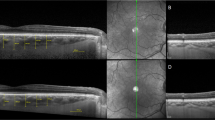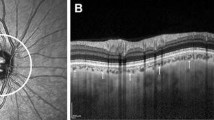Abstract
Purpose
To measure changes in choroidal thickness (CT), retinal thickness (RT), and axial length (AL) accompanying intraocular pressure (IOP) increase and to investigate the changes in axial eye dimensions induced by IOP increase.
Methods
Thirty-four eyes of 34 patients undergoing a diagnostic provocative test for primary angle closure (PAC). Patients with other macular diseases were excluded. Patients underwent the darkroom prone provocative test (DR-PPT) for 1 h. We measured CT and RT at the fovea by optical coherence tomography with the enhanced depth imaging method and AL with noncontact, partial coherence laser interferometry before and after the DR-PPT.
Results
There was a statistically significant increase in the mean (SD) IOP of 7.3 (9.2) mmHg and the mean (SD) AL of 0.06 (0.12) mm after the DR-PPT (P < 0.001 and P = 0.014, respectively). There was a statistically significant decrease in the mean (SD) subfoveal CT of 30.0 (36.8) μm (P < 0.001), while there was no significant change in the mean foveal RT. The change in subfoveal CT was negatively correlated with the changes in IOP (r = −0.71, P < 0.001) and AL (r = −0.54, P = 0.004).
Conclusions
In eyes suspected of having PAC, acutely increased IOP accompanies choroid thinning and corresponding elongation of the optical axis.




Similar content being viewed by others
References
Hayreh SS. Blood supply of the optic nerve head and its role in optic atrophy, glaucoma, and oedema of the optic disc. Br J Ophthalmol. 1969;53:721–48.
Imamura Y, Engelbert M, Iida T, Freund KB, Yannuzzi LA. Polypoidal choroidal vasculopathy: a review. Surv Ophthalmol. 2010;55:501–15.
Chan WM, Ohji M, Lai TY, Liu DT, Tano Y, Lam DS. Choroidal neovascularisation in pathological myopia: an update in management. Br J Ophthalmol. 2005;89:1522–8.
Komatsu H, Young-Devall J, Peyman GA, Yoneya S. Choriocapillary blood propagation in normal volunteers and in patients with central serous chorioretinopathy. Br J Ophthalmol. 2010;94:289–91.
Maruko I, Iida T, Sugano Y, Ojima A, Ogasawara M, Spaide RF. Subfoveal choroidal thickness after treatment of central serous chorioretinopathy. Ophthalmology. 2010;117:1792–9.
Guyer DR, Puliafito CA, Mones JM, Friedman E, Chang W, Verdooner SR. Digital indocyanine-green angiography in chorioretinal disorders. Ophthalmology. 1992;99:287–91.
Coleman DJ, Silverman RH, Chabi A, Rondeau MJ, Shung KK, Cannata J, et al. High-resolution ultrasonic imaging of the posterior segment. Ophthalmology. 2004;111:1344–51.
Spaide RF, Koizumi H, Pozzoni MC. Enhanced depth imaging spectral-domain optical coherence tomography. Am J Ophthalmol. 2008;146:496–500.
Ikuno Y, Kawaguchi K, Nouchi T, Yasuno Y. Choroidal thickness in healthy Japanese subjects. Invest Ophthalmol Vis Sci. 2010;51:2173–6.
Yasuno Y, Hong Y, Makita S, Yamanari M, Akiba M, Miura M, et al. In vivo high-contrast imaging of deep posterior eye by 1-microm swept source optical coherence tomography and scattering optical coherence angiography. Opt Express. 2007;15:6121–39.
Margolis R, Spaide RF. A pilot study of enhanced depth imaging optical coherence tomography of the choroid in normal eyes. Am J Ophthalmol. 2009;147:811–5.
Fujiwara A, Shiragami C, Shirakata Y, Manabe S, Izumibata S, Shiraga F. Enhanced depth imaging spectral-domain optical coherence tomography of subfoveal choroidal thickness in normal Japanese eyes. Jpn J Ophthalmol. 2012;56:230–5.
Fujiwara T, Imamura Y, Margolis R, Slakter JS, Spaide RF. Enhanced depth imaging optical coherence tomography of the choroid in highly myopic eyes. Am J Ophthalmol. 2009;148:445–50.
Cashwell LF, Martin CA. Axial length decrease accompanying successful glaucoma filtration surgery. Ophthalmology. 1999;106:2307–11.
Leydolt C, Findl O, Drexler W. Effects of change in intraocular pressure on axial eye length and lens position. Eye (London). 2008;22:657–61.
Read SA, Collins MJ. The short-term influence of exercise on axial length and intraocular pressure. Eye (London). 2011;25:767–74.
Read SA, Collins MJ. Water drinking influences eye length and IOP in young healthy subjects. Exp Eye Res. 2010;91:180–5.
Uretmen O, Ates H, Andac K, Deli B. Axial length changes accompanying successful nonpenetrating glaucoma filtration surgery. Ophthalmologica. 2003;217:199–203.
Nemeth J, Horoczi Z. Changes in the ocular dimensions after trabeculectomy. Int Ophthalmol. 1992;16:355–7.
Chakraborty R, Read SA, Collins MJ. Diurnal variations in axial length, choroidal thickness, intraocular pressure, and ocular biometrics. Invest Ophthalmol Vis Sci. 2011;52:5121–9.
Quigley HA, Friedman DS, Congdon NG. Possible mechanisms of primary angle-closure and malignant glaucoma. J Glaucoma. 2003;12:167–80.
Hyams SW, Friedman Z, Neumann E. Elevated intraocular pressure in the prone position: a new provocative test for angle-closure glaucoma. Am J Ophthalmol. 1968;66:661–72.
Neumann E, Hyams SW. Gonioscopy and anterior chamber depth in the prone-position provacative test for angle-closure glaucoma. Ophthalmologica. 1973;167:9–14.
Nonaka A, Kondo T, Kikuchi M, Yamashiro K, Fujihara M, Iwawaki T, et al. Cataract surgery for residual angle closure after peripheral laser iridotomy. Ophthalmology. 2005;112:974–9.
Sihota R, Mohan S, Dada T, Gupta V, Pandey RM, Ghate D. An evaluation of the darkroom prone provocative test in family members of primary angle closure glaucoma patients. Eye (London). 2007;21:984–9.
Kiernan DF, Mieler WF, Hariprasad SM. Spectral-domain optical coherence tomography: a comparison of modern high-resolution retinal imaging systems. Am J Ophthalmol. 2010;149:18–31.
Drexler W, Findl O, Menapace R, Rainer G, Vass C, Hitzenberger CK, et al. Partial coherence interferometry: a novel approach to biometry in cataract surgery. Am J Ophthalmol. 1998;126:524–34.
Kiel JW, van Heuven WA. Ocular perfusion pressure and choroidal blood flow in the rabbit. Invest Ophthalmol Vis Sci. 1995;36:579–85.
Aihara M, Lindsey JD, Weinreb RN. Episcleral venous pressure of mouse eye and effect of body position. Curr Eye Res. 2003;27:355–62.
Kurimoto Y, Park M, Sakaue H, Kondo T. Changes in the anterior chamber configuration after small-incision cataract surgery with posterior chamber intraocular lens implantation. Am J Ophthalmol. 1997;124:775–80.
Jacobi PC, Dietlein TS, Luke C, Engels B, Krieglstein GK. Primary phacoemulsification and intraocular lens implantation for acute angle-closure glaucoma. Ophthalmology. 2002;109:1597–603.
Acknowledgments
The authors had no financial support or financial conflict of interest. Contributions of authors: design (MH); collection (MH, FH), analysis, and interpretation (MH, FH, AO) of the data; and preparation (FH, AO, YH), review (FH, AO, YH, YK), and approval (MH, FH, AO, YH, YK) of the manuscript. All procedures conformed to the tenets of the Declaration of Helsinki, and the study design was prospectively approved by the institutional review board of Kobe City Medical Center General Hospital. The review board waived the need for written informed consent for reviewing the retrospective data.
Author information
Authors and Affiliations
Corresponding author
About this article
Cite this article
Hata, M., Hirose, F., Oishi, A. et al. Changes in choroidal thickness and optical axial length accompanying intraocular pressure increase. Jpn J Ophthalmol 56, 564–568 (2012). https://doi.org/10.1007/s10384-012-0173-0
Received:
Accepted:
Published:
Issue Date:
DOI: https://doi.org/10.1007/s10384-012-0173-0




